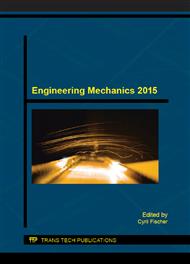p.392
p.399
p.405
p.412
p.420
p.428
p.435
p.442
p.450
Testing of Energy Absorption Capability of Sandwich Structures Based on Metal Foams for Design of Protective Helmets
Abstract:
Purpose of this study is investigation of energy absorption capability of the sandwich structures composed of combination of polystyrene and metal foam element and their suitability as new structure for design of protective helmets. Two types of the metal foams were experimentally tested and evaluated: Alporas (Shinko Wire Ltd., Japan) and Aluhab (Aluinvent Plc., Hungary). Samples of the sandwich structure are composed of two layers: bottom expanded polystyrene (EPS 200S) layer and upper metal foam layer which are glued together. Prepared samples are tested using a drop tower experiment to measure sample response (acceleration, reaction force) at different strain rates and energies. From acceleration/time history the Head Injury Criterion (HIC) is calculated as significant parameters in terms of protective helmets. Moreover, measured and derived characteristics are compared with pure EPS samples to obtain comparison of deformation behaviour between conventional structure for protective helmets and designed sandwich structures.
Info:
Periodical:
Pages:
420-427
Citation:
Online since:
January 2016
Authors:
Keywords:
Price:
Сopyright:
© 2016 Trans Tech Publications Ltd. All Rights Reserved
Share:
Citation:


